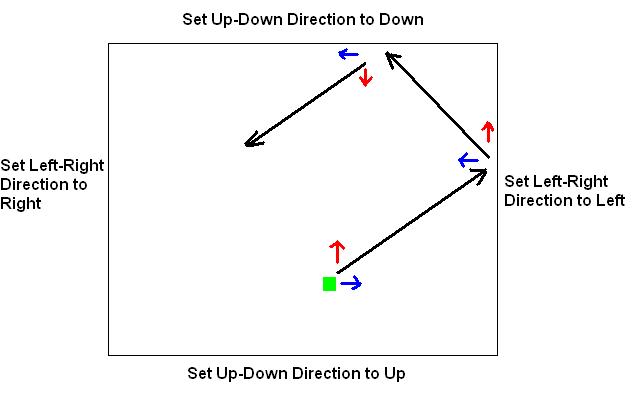Thinking Inside the Box
However, now that we have movement, we run into an issue. When we think of a classic video game, we think of boundaries, such as the edge of the screen, or floors/walls/ceilings, or other objects. In many games, such as platformers, these boundaries will stop the object from moving. In games such as Pong and Breakout/Arkanoid, the boundaries cause the object to bounce.

In the classic game Breakout, the ball bounces off the walls, paddle, and bricks.
The idea of bouncing is the boundary only reverses one dimension of the ball’s direction, while the other dimensions remain unaffected. This is expected behavior that reflects real life, as remember that vectors are treated independently in each dimension. E.g. if the ball is traveling right and up, and hits the right wall, it should continue to travel up, but it should start traveling left. The right wall only affects the left-right dimension, it never affects the up-down direction. If the ball then hits the ceiling traveling left and up, the ceiling will only affect the up-down direction, and now the ball starts traveling left and down.

Each wall only affects the direction in one dimension.
Looking back, our program currently has 4 variables. X (x position), Y (y position), VelX (x velocity), and VelY (y velocity). When redrawing our screen, in the case of boundaries, we would check to see if the ball has “hit” any boundaries – that is, if the coordinates of the ball (X and Y) reside in the same space as the coordinates of any of the boundaries. If so, we adjust the velocity accordingly. E.g. if the ball has an x velocity of 4 (traveling 4 pixels per redraw to the right) and a y velocity of -2 (traveling 2 pixels per redraw downwards), and hits the right wall, the x velocity will be reversed – that is, multiplied by -1 (VelX = VelX * -1). So now the x velocity is -4 (traveling 4 pixels per redraw to the left), and we’ve achieved our bounce. If we apply this boundary check to a movable paddle, we now have pong. If we apply this boundary check to bricks at the top of the screen, we now have breakout as well!
Onto Part 4
 Hello - and thanks for visiting my site! I maintain ToniWestbrook.com to share information and projects with others with a passion for applying computer science in creative ways. Let's make the world a better and more beautiful place through computing! | More about Toni »
Hello - and thanks for visiting my site! I maintain ToniWestbrook.com to share information and projects with others with a passion for applying computer science in creative ways. Let's make the world a better and more beautiful place through computing! | More about Toni » 





Leave a Reply